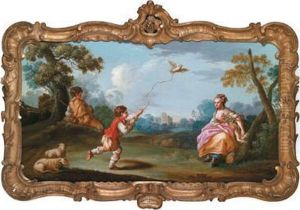Johan Jacob Sorg Paintings
Johan Jacob Sorg was a German painter and etcher who lived during the Baroque period. Born in 1654 in Augsburg, Bavaria, Sorg was a part of a family with a strong artistic tradition. His father, Matthäus Sorg, was also a painter, which likely had an influence on Johan Jacob's early artistic development.
Sorg's work is relatively obscure in the broader context of European art history, and detailed records of his life and work are scarce, which is not uncommon for artists of his time, especially those who did not achieve wide fame or were not associated with major courts or artistic centers. However, it is known that he was active during the late 17th and early 18th centuries, a time when the Baroque style was predominant in European art.
The Baroque style, characterized by its dramatic use of light, rich color, and dynamic compositions, is evident in Sorg's paintings. While specific works by Sorg may not be well-documented or widely recognized today, his contributions would have been a part of the rich tapestry of Baroque art that flourished in Southern Germany during his lifetime. It is likely that Sorg's work included religious subjects, as was typical for the period, as well as possibly portraits and genre scenes.
Johan Jacob Sorg passed away in 1729. Unfortunately, due to the lack of comprehensive historical records, Sorg's artistic legacy is not as well-preserved or studied as that of some of his contemporaries. Nevertheless, his existence as a working artist during the Baroque period makes him a figure of interest for those studying the nuances and breadth of German art during the 17th and 18th centuries.


